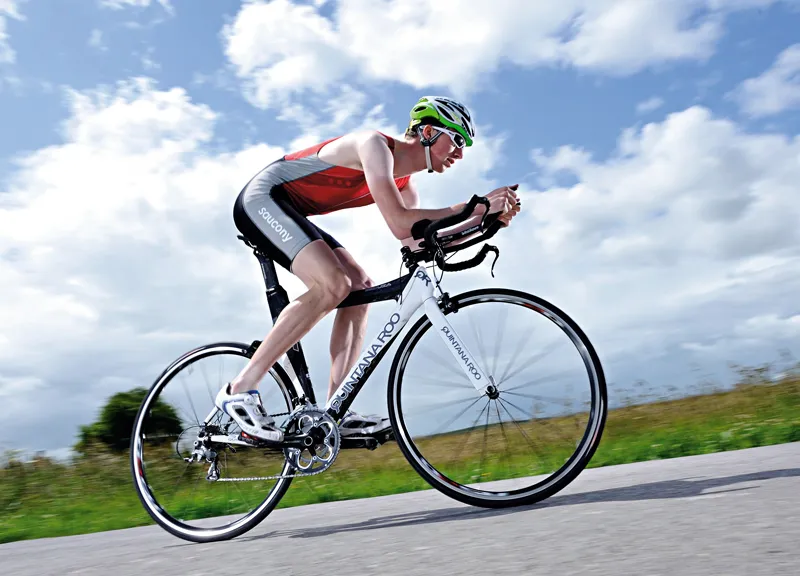Reconfigured ‘added comfort’ geometry and a recent price drop from £2,000 makes the friendly, totally carbon Seduza a very tempting and time-proven option in this price range.
Quintana Roo have taken a bold step towards the rider rather than the wind tunnel with all their 2011 bikes, but we think it’s a step in the right direction. The easy fit, comfort, smoothness and stability of the Seduza is seductive straight away. Its solo speed on longer runs is boosted by it’s relaxing, fatigue-reducing character too, making it a great-value choice for distance athletes.
Ride & handling: Excellent ergonomics and handling mean even long rides are fun
Many brands are vanishing up their own wind tunnel, seemingly happy to sacrifice everything else for lower drag numbers. Refreshingly, Quintana Roo have bucked the trend by putting the rider first. While a slightly taller headtube doesn’t sound much – particularly when, for many bikes of this type, long fork steerer tubes and a stack of height rise spacers under the stem all come as standard – the Seduza fit was eponymously seductive to all our riders within a few quick turns of an allen key.
The carbon frame with its skinny top tube and curving tube forms does a remarkably good job of making a basic aero bar and saddle set-up feel luxuriously comfortable, however long the day’s ride. There’s a slight bit of bar flex if you’re honking uphill, but otherwise everything falls easily to hand and the internal cable routing never got in the way.
As you’d hope for a manufacturer as experienced with aero-style bikes as Q Roo, the handling is absolutely spot on. It’s quick-witted enough to whip through roundabouts or dodge potholes, but steady and faithful as a seaside donkey when you’re knackered and want as much help fighting a gusty homeward headwind as you can get. It’s a quiet bike too, which all helps towards a notably serene and smooth character, whatever cardiac level you’re cruising at.
The downside is a less dynamic feel than the sharpest bikes we’ve ridden at this price point. However, while initial kick is less sharp and crisp than some, it gathers speed well and holds on to it even better, so it was never far from the fight when we took a range of test bikes out on combat missions.
Frame: Reasonably light and comfortable carbon aero chassis for the money
The Seduza is a classic example of a frame that’s used on more expensive bikes – in this case the £2,250 (was £3,000) Lucero, and it certainly looks the part for that price range rather than the sub-£2,000 mark. In common with all 2011 Roos, the headtube has been lengthened for a more upright, age-group/fitness-rider friendly posture. It also gets a pointed front edge and teardrop seatstays borrowed from the wind tunnel work on the top CD.0.1 model.
A big headbox tapers into thinner, ovalised down and top tubes, with a brake cable routed through the top tube and a gear cable through the downtube. The downtube flares out again round the bottom bracket, leading into chunky chainstays where the rear gear cable pops out again. The rear dropouts get set screws for adjusting clearance against the wheelhugger seat-tube cut-out. They’re fully replaceable on both sides too, which is reassuring in the event of a crash or transit damage.
The teardrop seat tube is topped by a slim teardrop carbon seatpost with a moveable cradle, allowing a 74- to 81-degree effective seat angle. Straight-legged aero forks plug in up front, while the front and rear brakes are conventionally mounted side-pulls for simple cable routing and access. It’s relatively heavy for a full carbon frame (again, not helped by lots of outer cable inside the frame), but light for a sub-£2,000 bike.
Equipment: Decent spec keeps weight down
A healthy equipment spec drops complete bike weight under the psychologically significant 20lb mark. The Shimano/FSA transmission mix is decent machinery too, again with a compact chainset that concentrates on letting you finish the bike leg comfortably rather than giving you gears to push beyond 40mph. While they’re not aero, the Shimano wheels are smooth and reliable spinners, and the Maxxis tyres are competent rollers.
The unbranded bar and stem are solid enough, if slightly narrow, and the Vision bars with their comfortably flexible arm rests and proper pads are a bonus on longer sessions. While it doesn’t look much, the saddle is OK, as long as you get the tilt angle right. Once you’ve worked out the clamping mechanism, setting your optimum fore/aft position on the slotted seatpost top is easy too. The brakes are deserving of an upgrade though to metal-backed cartridge brake pads to give them the firmer feel the conventional mounting should deliver.





